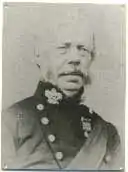Severus Stretton | |
|---|---|
 Severus Stretton's portrait at the Durham Light Infantry Museum | |
| Born | 7 November 1783 |
| Died | 22 November 1884 Southampton |
| Nationality | British |
| Employer | British Army |
| Known for | Lt. Colonel |
| Parent | William Stretton |
Lieutenant-Colonel Severus William Lynam Stretton (7 November 1792 – 22 November 1884) was a British Army officer who served in the Napoleonic Wars.[1]
Family
He was the youngest child of William Stretton and was baptised at St. Mary's Church, Nottingham, on 29 May 1793. His name of Severus followed his parents habit of naming their children with unusual names that begin with "S". He was their second child called Severus as an earlier child had died young ten years before.[1]
On 24 October 1851 he married the Hon. Catherine Adela de Courcy (b.1831),[2] youngest daughter of John Stapleton de Courcy, 28th Baron Kingsale. There were seven daughters and one son from the marriage:
- Sarah A. C. Stretton, born 1855.
- Florence C. Stretton, 1857.
- Catherine M. Stretton, 1859.
- Frances A. Stretton, 1861.
- William de Courcy Stretton, 1862, who became a lieutenant in the Royal Artillery, and wrote the words to the song Follow the Colours set to music by Sir Edward Elgar.
- Susanna E. Stretton, 1864.
- Amy Stretton. 1867.
- Gertrude Stretton, 1862.
He died at Southampton on 22 November 1884.
Career
He obtained a commission in the Nottinghamshire Militia in Plymouth in 1810, and accompanied the regiment to Ireland. In 1812 he obtained an ensigncy in the 68th (Durham) Regiment of Foot (Light Infantry), and joined the regiment in Portugal, serving in the second Peninsular campaign of 1812–13.[1]
Having been severely wounded at the Battle of Vittoria on 21 June 1813, by two musket balls which lodged in his body. He was removed, in a very precarious state, to England.[1] (Prior to this, one of the balls was extracted, but the other, at different periods, was a source of great trouble and pain, relieved only by severe surgical operations until it was successfully extracted in 1870.) The medical treatment he received at his father's house at Lenton Priory restored him so far that after twelve months he was enabled to rejoin his regiment stationed in Ireland.[1]
He accompanied the same regiment to Canada in 1818, and in 1825 was promoted to an unattached company, shortly after which he exchanged to the 64th (2nd Staffordshire) Regiment of Foot, and joined it at Gibraltar. He was promoted major in 1832.[3] He succeeded to the lieutenant-colonelcy and command of this regiment in 1842, having accompanied it to the West Indies and Nova Scotia, from whence he returned with it in 1843. He had, in the meantime, inherited the Lenton property from his brother Sempronius Stretton but never resided there.[1]
Lieutenant-Colonel Stretton, in 1848, exchanged to his brother's old regiment, the 40th (2nd Somersetshire) Regiment of Foot, of which he retained the command until June, 1852. He was awarded the Military General Service Medal and was also in receipt of a pension for wounds.
He retired in 1852 from active service, but three years later was appointed to the command of the Hampshire Artillery Militia, which he held until 1868, when he retired at the age of 75.
In 1862 Colonel Stretton was appointed a Justice of the Peace for the Borough of Southampton, and he took an active part in the management of the Royal South Hampshire Infirmary, Southampton Dispensary and other charitable institutions in the town.[1]
His medals are held in Medal Case 27, Display Group 24 in the Durham Museum and Art Gallery.
References
- 1 2 3 4 5 6 7 The Stretton Manuscripts, being notes on the History of Nottinghamshire by William Stretton (of Lenton Priory) Died 1828. John T. Godfrey. Privately Printed. Nottingham 1910, accessed 27 October 2010
- ↑ Burke's Peerage, Baronetage & Knightage, 107th edition, 3 volumes (Wilmington, Delaware, U.S.: Burke's Peerage (Genealogical Books) Ltd, 2003), volume 2, page 2176.
- ↑ The United service magazine, 1832. P131.